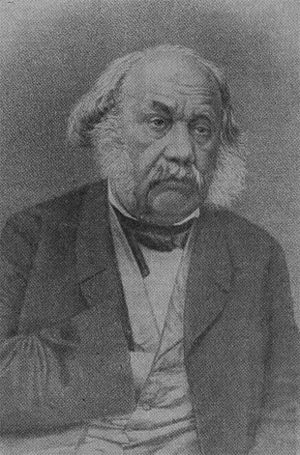Nikolai Turczaninow facts for kids
Quick facts for kids
Nikolai Turczaninow
|
|
|---|---|

Nikolai Turczaninow
|
|
| Born | 1796 Nikitovka, now Krasnogvardeysky District, Belgorod Oblast, Russia
|
| Died | 1863 (aged 66–67) |
| Scientific career | |
| Fields | Botany |
Nikolai Stepanovich Turczaninow (Russian: Николай Степанович Турчанинов) was a Russian botanist. He was born in 1796 in Nikitovka, which is now part of Krasnogvardeysky District, Belgorod Oblast, Russia. He passed away in 1863 in Kharkov.
Nikolai Turczaninow was famous for finding and describing many new types of plants. He was the first to identify several plant groups (genera) and many individual plant species.
Contents
Becoming a Botanist
Nikolai Turczaninow was born in 1796. He went to high school in Kharkov. In 1814, he finished his studies at Kharkov University.
After university, he worked for the government in St. Petersburg. Even though his job was not about plants, he loved botany. He taught himself a lot about plants.
First Plant Discoveries
In 1825, Turczaninow published his first list of plants. This showed his passion for botany, even while working in a different field.
In 1828, he got a new job in Irkutsk, Siberia. This was a great chance for him! He could now collect plants around Lake Baikal. This area is known for having many different kinds of plants and animals.
He wrote many papers about his findings. He also started his own herbarium. A herbarium is like a library for dried plant samples. His herbarium held many plants from the Lake Baikal region.
Working with Important Botanists
In 1830, Turczaninow became a Fellow of the Imperial Botanic Garden St. Petersburg. This meant he was asked to collect plants from Siberia.
In the early 1830s, he wrote many articles about plants from Siberia and Mongolia. These articles often appeared in a science magazine called Bulletin de la Société impériale des naturalistes de Moscou.
During his life, Turczaninow talked and shared plant samples with many famous botanists. These included Augustin Pyramus de Candolle, George Bentham, and Joseph Dalton Hooker.
Exploring New Regions
In 1837, he moved to Krasnoyarsk. There, he kept finding and naming new plants. He also became the governor of that region.
Later, Turczaninow opened another herbarium in Taganrog. This city is on the Sea of Azov.
After a bad fall, he could not collect plants himself anymore. So, other people collected plants for him. He then spent his time studying, classifying, and writing about these plants.
He worked on plant collections sent from Western Australia by a botanist named James Drummond. Even though Turczaninow never went to Australia, he described over 400 new plant species from there!
His Plant Collection
In 1847, Turczaninow moved back to Kharkov. He took most of his herbarium with him. Many of his plant samples, including important "type specimens" (the original plant used to describe a new species), are now at the National Herbarium of Ukraine (KW).
Many other plant collections around the world also have plants collected by Turczaninow. These include the Komarov Botanical Institute and the Royal Botanic Gardens, Melbourne in Australia. Also, Harvard University Herbaria and the Royal Botanic Gardens, Kew in England have his samples.
Plant Naming and Legacy
Nikolai Turczaninow named almost 2500 different plant species! You can see a list of plants he named here: Category:Taxa named by Nikolai Turczaninow and International Plant Name Index.
Awards and Recognition
- 1857: He won the Demidov Prize from the Russian Academy of Sciences. This was a very important award for his scientific work.
How He is Remembered
- A science journal called Turczaninowia is named after him. This journal publishes articles about plant classification and diversity.
- Several plant species are named in his honor. These include Connarus turczaninowii, Hydrocotyle turczaninowii, and Sisymbrium turczaninowii.
- In 1836, another botanist named Augustin-Pyramus de Candolle named a plant group Turczaninovia after him. This group has only one type of flowering plant and is found from Russia to China. It belongs to the daisy family, Asteraceae.
See also
 In Spanish: Nikolai Turczaninow para niños
In Spanish: Nikolai Turczaninow para niños
- Saposhnikovia

